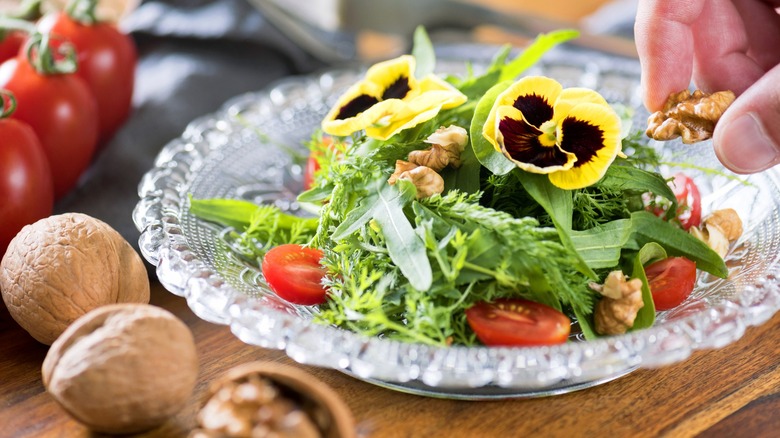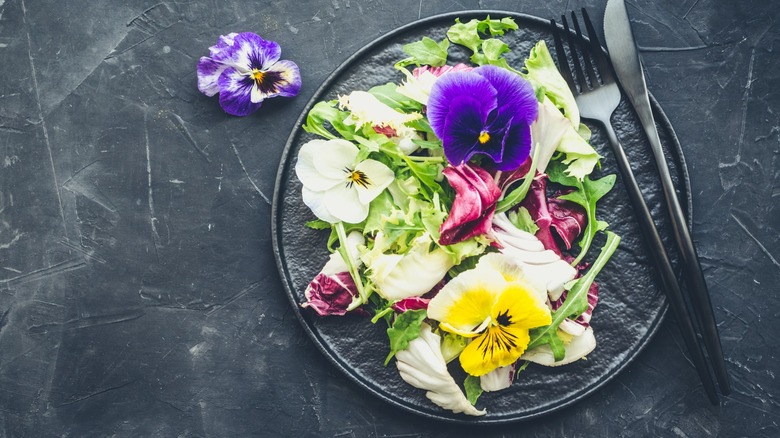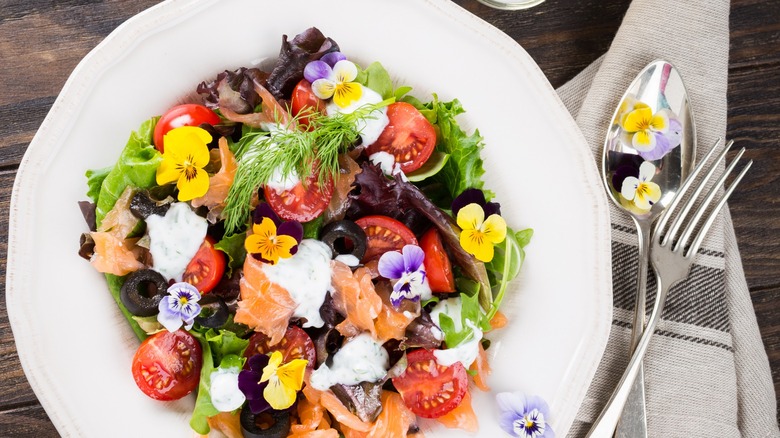Adding Edible Flowers Is A Gorgeous Way To Elevate Your Salad
Salads make for a great refreshing and light meal or side, but they often don't get the credit they deserve. When push comes to shove, most diners aren't going to jump for joy upon receiving a salad like they would when offered filet mignon or a rack of lamb. This is because salads can arguably be pretty basic regarding ingredients and presentation. Nevertheless, there's one way you can heighten the dish, taking it from standard fare to gourmet, and it's by simply including some edible flowers.
While some may not be accustomed to eating these consumable, colorful garnishes directly, there's a good chance you've probably eaten one without realizing it. After all, figs aren't a fruit but rather a flower. Moreover, edible flowers have a long culinary history, with records showing the utilization of the ingredient among Romans, Chinese, Indian, and Middle Eastern civilizations, so why not join the party? Not only do they provide an extra splash of color within a salad, but also a touch of flavor, and that's always a good thing.
What are edible flowers?
Edible flowers come in all shapes and sizes, and there's a long list (that you probably didn't know you could eat) to choose from depending on what you're going for in terms of color and taste. Some of these flowers come from herbs you already have in your pantry. These include lavender, mint, thyme, arugula, and cilantro, which are all lovely seasonings. Still, because their flowers are fit for consumption and tend to taste just like their herbal counterparts, they shouldn't be left out, especially since edible flowers add a touch of texture along with their flavor.
"I use them in dishes, not only as a beautiful sort of confetti garnish, but to offer the different personalities of an ingredient... to really showcase the entirety of that ingredient's lifespan and flavors," said Chef Kelly Fields in Bon Appétit. "They're a great flavor booster and really contribute an unexpected textural contrast to the dish."
Moreover, these types of flowers add additional health value to salads. According to a study provided by the National Library of Medicine, some edible flowers contain phytochemical compounds that bestow advantages associated with "anti-oxidant, anti-inflammatory, anti-cancer, anti-obesity, and neuroprotective effect[s]." So, they'll not only turn an everyday salad into an elegant, tasty social media-worthy food post but might also give you a leg up healthwise.
Things to consider when eating edible flowers
You can certainly pick your own edible flowers, but this probably isn't the safest route. After all, you don't want to consume any flowers unless you know they come from a reputable source. Moreover, avoid those you may be allergic to (those with pollen allergies, beware) or those treated with pesticides.
Either way, even if you find some that are safe, that doesn't mean the entire flower should be eaten. According to the University of Minnesota, an edible flower's stamen and pistils should be sidestepped. As a result, you're really only meant to eat the petals, so make sure, regardless of whether they're store-bought, to check a package's contents thoroughly.
Still, don't let this scare you off either. A quick Google investigation can help you identify which flowers are edible, and there's also a reliable and searchable database by Plants For A Future that can streamline the process.
The last thing to consider is the flavor profile. For instance, most people are familiar with chamomile (mainly as a tea), but the name — according to Architectural Digest – stands for "ground apples." The reason why this is significant is because the typically dry flower also has similar undertones tastewise. So, it would complement dishes that would go great with or have apples. The same is true for anise hyssop, which, you guessed it, tastes similar to black licorice. In any respect, that means there's more room for playful taste-testing and enjoyable comparisons. Now get garnishing!


